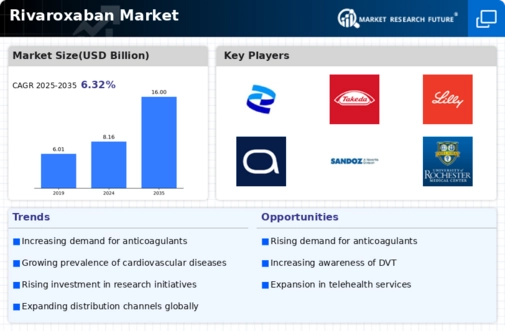Growing Geriatric Population
The Rivaroxaban Market is poised for growth due to the increasing geriatric population, which is more susceptible to thromboembolic disorders. As the global population ages, the prevalence of conditions such as atrial fibrillation and deep vein thrombosis is expected to rise. This demographic shift is particularly relevant, as older adults often require anticoagulation therapy to manage their health effectively. Data indicates that the elderly population is projected to grow significantly in the coming years, which will likely lead to an increased demand for Rivaroxaban Market. The drug's favorable dosing regimen and safety profile make it an attractive option for this demographic, further propelling market growth.
Advancements in Clinical Research
The Rivaroxaban Market is benefiting from ongoing advancements in clinical research, which are expanding the understanding of the drug's efficacy and safety profile. Recent studies have demonstrated Rivaroxaban Market's effectiveness in various patient populations, including those with renal impairment and elderly patients. This research is crucial as it supports the drug's use in a broader range of clinical scenarios, potentially increasing its market share. Moreover, the results of these studies are often published in reputable medical journals, further enhancing the credibility of Rivaroxaban Market. As more clinical evidence emerges, healthcare providers are likely to feel more confident in prescribing Rivaroxaban Market, thereby contributing to the overall growth of the market.
Regulatory Approvals and Guidelines
The Rivaroxaban Market is significantly influenced by regulatory approvals and updated clinical guidelines that endorse the use of Rivaroxaban Market for various indications. Regulatory bodies have been increasingly supportive of Rivaroxaban Market, granting approvals for new indications and formulations. For instance, recent guidelines from cardiology and hematology associations have recommended Rivaroxaban Market as a first-line treatment for certain thromboembolic conditions. This endorsement not only legitimizes the drug's use but also encourages healthcare providers to prescribe it more frequently. Consequently, the alignment of regulatory support with clinical practice is likely to enhance the market presence of Rivaroxaban Market, driving sales and adoption rates.
Technological Innovations in Drug Delivery
The Rivaroxaban Market is also being shaped by technological innovations in drug delivery systems. Advances in formulation technology have led to the development of more effective and patient-friendly delivery methods for Rivaroxaban Market. For instance, the introduction of fixed-dose combinations and novel delivery systems may enhance patient adherence to therapy. Improved adherence is crucial, as it directly impacts treatment outcomes and overall market performance. Furthermore, as healthcare systems increasingly focus on patient-centered care, the demand for innovative delivery solutions is likely to rise. This trend may create new opportunities for Rivaroxaban Market, positioning it favorably within the competitive landscape of anticoagulants.
Increasing Awareness of Anticoagulant Therapy
The Rivaroxaban Market is experiencing a notable increase in awareness regarding anticoagulant therapy among healthcare professionals and patients. This heightened awareness is largely attributed to educational initiatives and campaigns aimed at informing stakeholders about the benefits and risks associated with anticoagulants. As a result, more patients are being diagnosed and treated for conditions such as atrial fibrillation and venous thromboembolism. According to recent data, the number of patients receiving anticoagulant therapy has risen significantly, which is expected to drive the demand for Rivaroxaban Market. Furthermore, as healthcare providers become more knowledgeable about the advantages of Rivaroxaban Market over traditional therapies, the market is likely to see continued growth in adoption rates.

















Leave a Comment